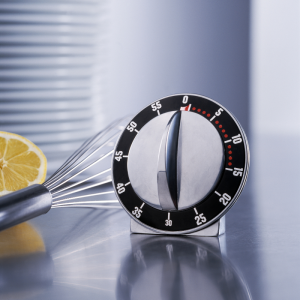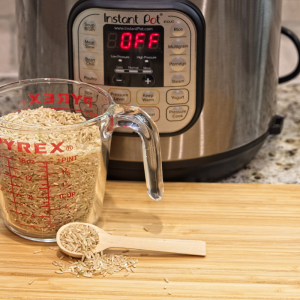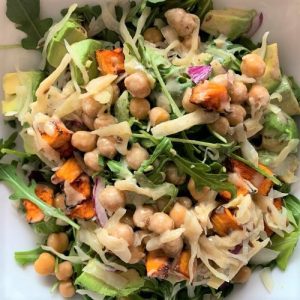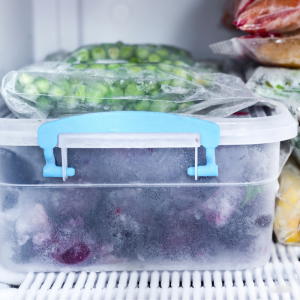 “But I don’t have time to cook.” I hear this pretty much every time I suggest to my clients that preparing their own food is one of the most powerful things they can do to improve their health. It doesn’t have to be all or nothing though. Because it is hard to find the time to cook from scratch every morsel you put in your mouth. But there are strategies and shortcuts you can employ to increase the proportion of home-cooked food you eat. And, by doing so, take control over your plate, palate and portion size for prime health.
“But I don’t have time to cook.” I hear this pretty much every time I suggest to my clients that preparing their own food is one of the most powerful things they can do to improve their health. It doesn’t have to be all or nothing though. Because it is hard to find the time to cook from scratch every morsel you put in your mouth. But there are strategies and shortcuts you can employ to increase the proportion of home-cooked food you eat. And, by doing so, take control over your plate, palate and portion size for prime health.
I have sprinkled many of these tips throughout previous posts. But I figured it was high time to gather them in one place. So, without taking up any more of your time, here are my top 10 time-savers in the kitchen.
1. Have a plan
 Remember the adage “If you fail to plan, you plan to fail”? Well, it’s true. If you wait until mealtime to say “gee, what shall I have for (insert meal here)?”, chances are what you end up eating is not going to be a healthy meal. If you are already short on time, poking around your fridge/freezer/pantry to figure out what to eat at the last minute is just making you more time-squeezed. And there’s a good chance that you won’t have an ingredient or what you want is frozen solid. So, inevitably, you end up picking up takeout or some prepared meal from the grocery store. In tip #10, I give you some strategies to make takeout a little healthier. But most of my tips help you avoid resorting to takeout in the first place.
Remember the adage “If you fail to plan, you plan to fail”? Well, it’s true. If you wait until mealtime to say “gee, what shall I have for (insert meal here)?”, chances are what you end up eating is not going to be a healthy meal. If you are already short on time, poking around your fridge/freezer/pantry to figure out what to eat at the last minute is just making you more time-squeezed. And there’s a good chance that you won’t have an ingredient or what you want is frozen solid. So, inevitably, you end up picking up takeout or some prepared meal from the grocery store. In tip #10, I give you some strategies to make takeout a little healthier. But most of my tips help you avoid resorting to takeout in the first place.
Your plan doesn’t have to be a full-on set of recipes for every meal you eat. You can simply “sketch out” a meal plan. For example, you might write on your plan:
- Monday – boneless chicken breast, broccoli and whole grain penne
- Tuesday – salmon, green beans and lentils
- Wednesday – black bean and brown rice bowl with bell peppers and baby spinach
- and so on for each day you are planning.
This approach works well for people that feel comfortable cooking on the fly and without a recipe. And here’s where tips #8 and #9 come in handy. They offer lots of ways to enhance flavour on the fly.
Some people feel more comfortable following a recipe. If that’s you, then start collecting recipes for quick and easy meals that can be whipped up in no time. This is generally my approach as often I am testing recipes that fit this criteria for my clients and for my blog. I like a detailed plan as it makes my shopping list very succinct and there is no waste. But even I plan nights off and treat myself to ordering in something special.
When you plan what you will eat ahead of time (and so have the ingredients ready and waiting), executing the plan is pretty fast and straightforward. This step may take an hour or two per week, but it pays off in huge time dividends later. Or (shameless self-promotion here), you can hire a nutritionist like me to design a meal plan or collection of healthy, quick and easy recipes that include your favourite foods.
2. Plan to have leftovers
I can’t stress enough how important it is to make sure your plans include liberal use of leftovers. Most of the time, my lunch is simply leftovers from dinner the night before. Since I eat two meals per day, that means I only need to cook once per day. It saves me a lot of time.
If you find it boring to have exactly the same thing the next day, you can mix it up:
- stagger things so leftovers aren’t lunch the next day but the day after or
- switch it up a bit; for example, if your dinner was roast chicken and root vegetables with some steamed broccoli, make extra chicken and root vegetables and then serve them over a bed of greens with a tasty dressing the next day, or add all that to a wrap with some hummus.
You can also front-end load things by batch cooking either prepared meals or components of meals on the weekend when you tend to have more time. Soups, stews, curries and such all freeze very well. So you could cook a few and portion them out so you have a selection of ready made meals in the freezer at all times. Then just thaw, add a veggie and you are good to go.
If you don’t want to prepare complete meals ahead, you can batch cook components, especially items that can take a while to cook, such as:
- legumes – chickpeas, black beans, white beans etc. (you could cook lentils ahead as well but, as they are pretty fast to cook and can get mushy, I usually do them the day I eat them, unless I’m using them in soup)
- whole grains – brown rice, barley, bulgur, farro, quinoa etc. (quinoa only takes about 15 minutes to cook, so it is a good choice if you need to cook something up in a hurry)
- you could also cook chicken breasts or fillets of salmon ahead but I prefer preparing them when I plan to eat them as they are generally quick to cook
Consider whether what you are making is a good candidate for a meal of leftovers. A dressed green salad, for example, will not be appetizing the next day unless limp greens are your thing. But cabbage salads and slaws as well as salads made from hearty kale leaves or marinated veggies are awesome for leftovers.
For more about leftovers, see my February 2020 post Top 10 Reasons to Love Your Leftovers.
3. Use time-saving tech: pressure cooker / slow cooker / microwave
 This is the companion tip to the one above. These fast and slow cookers are great! They require no oversight once you turn the device on and, in the case of pressure cookers, they can speed up cooking time considerably. They are great for making big batches of those freezable soups, stews and curries.
This is the companion tip to the one above. These fast and slow cookers are great! They require no oversight once you turn the device on and, in the case of pressure cookers, they can speed up cooking time considerably. They are great for making big batches of those freezable soups, stews and curries.
And I love, love, love my Instant Pot for making perfect brown rice (it never sticks or burns and I can totally ignore it while it is cooking). Legumes cook in a fraction of the time under pressure as well. I use mine so frequently that I finally made space in the kitchen for it so I wouldn’t have to keep hauling it up from the basement.
Don’t forget your microwave for speedy cooking. To quote Harvard Medical School, “the cooking method that best retains nutrients is one that cooks quickly, heats food for the shortest amount of time, and uses as little liquid as possible.” For this reason, microwaving foods generally preserves their nutrient value better than many other methods. I use mine frequently for quickly cooking vegetables like beans or broccoli as well as for reheating foods. And the defrost function is handy if I forget to move something from the freezer to the fridge to thaw overnight. When microwaving foods, always remember to vent the container and glass containers are best.
4. Become best buds with bean and grain bowls
 These work wonderfully if I am sketching out a meal plan or just want to whip something up last minute. I always have beans on hand, either because I’ve made up a batch in my Instant Pot or I use organic canned beans, well rinsed and drained. I also have brown rice handy, again having made up a batch ahead. In a pinch, I might resort to a small stash I keep of microwaveable brown rice. I like Tilda’s because it is wholegrain brown basmati rice without any seasonings or salt added. Quinoa is great for bowls also. You can make it ahead but it takes only about 15 minutes to prepare.
These work wonderfully if I am sketching out a meal plan or just want to whip something up last minute. I always have beans on hand, either because I’ve made up a batch in my Instant Pot or I use organic canned beans, well rinsed and drained. I also have brown rice handy, again having made up a batch ahead. In a pinch, I might resort to a small stash I keep of microwaveable brown rice. I like Tilda’s because it is wholegrain brown basmati rice without any seasonings or salt added. Quinoa is great for bowls also. You can make it ahead but it takes only about 15 minutes to prepare.
Then it is simply a matter of serving up your favourite beans and/or grains and adding extras as desired. These can be any combo of leftover roasted veggies, salad greens or other veg you may have on hand. Finish by drizzling on a dressing and adding some garnishes (see tips #8 and #9). Here are some ideas:
- A taste of Mexico: black beans, quinoa, red pepper, broccoli, avocado, cilantro and lime
- Asian-inspired: tofu (I love Ying Ying Soy Foods Gourmet Tofu if I don’t want to season my own), brown rice, spinach, edamame, cucumber and radish with sesame seeds and a miso dressing for an Asian twist.
- Mediterranean: lentils, leftover balsamic-roasted veggies like zucchini, bell peppers and red onion over baby kale with feta, slivered almonds and an oil and vinegar dressing.
- Kitchen sink: Use up what you need to use up! I just made one (pictured here) with chickpeas, roasted butternut squash, my homemade sauerkraut, avocado, red onion and arugula with lemon tahini dressing and it was fab. Combos are limited only by your imagination.
For a quick rice and grains bowl of another type, I’m a big fan of locally made Soup Girl Soups. She offers fifteen dried soup blends, so I never get bored. I just made her new Spicy Coconut Lentil Soup. All I need to do is add eight cups of water and then simmer as instructed. When cooked, I add in great big handfuls of leafy greens and stir until wilted. Sometimes I sprinkle on some pumpkin or sunflower seeds, fresh herbs and/or a squeeze of lime or some hot sauce before serving (see tip #9 for ideas). Each jar makes four very generous servings. Her website provides cooking instructions for stovetop, slow cooker and pressure cooker. Lunch couldn’t be simpler.
5. One pan/pot/skillet dinners are low stress and quick to clean up
One of my fave time-savers, as I mentioned in my A Flash in One Pan Dinners recipe collection I posted a few weeks ago, are dinners that can be cooked all in one pan, pot, skillet or tray. This means much lower stress cooking as everything is in one place and ready at the same time. It also means less mess to clean up. And one pan/pot dinners generally work well for leftovers. See my last post for a few recipe ideas.
6. Take pre-washed greens and slaw mixes for a spin
Another time-saver is pre-washed greens (arugula, kale, spinach, spring mix and so on). I use greens daily – in salads and bean and grain bowls and I toss handfuls into soups, stews, curries or frittatas and omelettes to get my quota of leafy greens. Eating leafy greens daily is so important that I’m focusing on them in next month’s menu. I also like slaw mixes (like PC Broccoli Slaw or PC Kale Slaw). These save a lot of chopping time! They can be used for salads but also as a base for stir-fries or sautés and as a topping for tacos.
7. Chill in the kitchen with frozen fruits and veggies
 Frozen fruits and veggies are awesome as you can always have them on hand and you don’t need to spend time washing or chopping. I love frozen berries as they are more economical and more nutritious and flavourful than fresh when out of season. They are great for yogurt in the morning or in smoothies. I like to add frozen (and thawed, of course) pineapple or avocado to Mexican food. Mango is nice with Thai or Indian curries. And frozen pomegranate seeds are fantastic with Middle Eastern dishes or on top of salads (saving you the fiddly chore of extracting them from whole pomegranates).
Frozen fruits and veggies are awesome as you can always have them on hand and you don’t need to spend time washing or chopping. I love frozen berries as they are more economical and more nutritious and flavourful than fresh when out of season. They are great for yogurt in the morning or in smoothies. I like to add frozen (and thawed, of course) pineapple or avocado to Mexican food. Mango is nice with Thai or Indian curries. And frozen pomegranate seeds are fantastic with Middle Eastern dishes or on top of salads (saving you the fiddly chore of extracting them from whole pomegranates).
As for veggies, I always have on hand frozen cauliflower (especially riced cauliflower), peas, corn, edamame and butternut squash. Frozen broccoli is fine too though I almost always have fresh on hand. These can be roasted, sautéed or stir-fried or added to soups, stews and bowls.
8. Pop your flavours with prepared pestos, salsas, curry pastes and salad dressings
I am not a fan of prepared foods. Most are loaded with less-than-savoury ingredients like added sugars, too much sodium or poor quality fats, not to mention additives and food colourings. But there are some good quality prepared foods out there and they do save time. You just have to read the labels carefully. Once you have found an excellent brand, you are good to go, though it may take a little investigation and perseverance to find one. They are usually a little pricier but you get what you pay for. Here are some of my favourites and ideas of how I use them:
- Sunflower Kitchen Pestos – these are great to elevate any grilled meat or fish, wonderful on pasta and fabulous in grain and rice bowls.
- Mad Mexican Salsas – I love these for taco dinners or in grain and rice bowls. Their Salsa Morita is a particular favourite. You won’t find any added sugar here though sadly the same can’t be said of all salsa brands.
- Mekhala Thai Curry Pastes – red, green, yellow, Thai basil garlic and Tom Yum (all organic) – just add to any combo of veggies, legumes, seafood or meat along with coconut milk and serve over brown rice.
- Nerpy’s Jerk Seasoning – for a taste of the Caribbean when you can’t go there, I love this on pretty much everything (tonight’s dinner is a jerked shrimp, bell pepper, red onion and pineapple tray bake with brown rice and sautéed collard greens)
- For salad dressings, I usually just add olive oil and my vinegar of choice. However, if I want something a little more involved but don’t feel like making it, I turn to Lemon Tahini Dressing or Peanut Ginger Dressing by Toronto-based Earth & City or Mother Raw Caesar Dressing. All feature organic, cold pressed olive oil. And the ingredient lists read like those in the recipes I would use were I to make them myself. Always read the labels of any commercially prepared salad dressings very carefully. Most include inferior soybean oils, added sugars, preservatives and other food additives.
9. Try these simple and speedy flavour-enhancers
These pantry staples go a long way toward jazzing up any meal:
- nuts – slivered almonds, tamari almonds, walnuts, pecans (these, like seeds, add wonderful texture as well as nutrition)
- seeds – pumpkin, sunflower, sesame and hemp (I toast up a bunch of mixed pumpkin and sunflower seeds and keep them in a jar ready to sprinkle on all sorts of things); also pomegranate seeds (see frozen fruit, above)
- fruit – apples, clementines, red grapes, dried cranberries and mangos are great both in salads and cooked dishes (see my One Pan Chicken, Grapes & Veggies recipe for one example)
- olive oil – many nutrients in vegetables are fat soluble, so drizzling olive oil on veggies not only tastes great (so you will enjoy them more), it improves nutrient absorption and provides health-promoting anti-oxidants
- citrus juices and vinegars (apple cider, red wine, balsamic, brown rice) – acid, like salt, brightens and enhances flavours and vitamin-C containing citrus juices (e.g. lemon, lime, orange) will also help convert plant-based (non-heme) iron into a form more easily used by your body
- Dijon mustard – make a classic vinaigrette with olive oil, Dijon and red wine vinegar, mix with plain yogurt, olive oil or real mayonnaise and use to marinate fish or chicken before roasting (or to help breading stick), stir a little into soups and stews or simply serve it alongside anything (mix Dijon with a bit of honey or sriracha, or both, for a tasty sauce)
- herbs (cilantro, parsley, thyme, oregano, rosemary, sage, dill and so on) – sprinkling any of these on a finished dish takes it to a new level; if you don’t want the bother of washing and chopping fresh herbs, then dried is fine for use in cooked dishes (just remember 1 teaspoon of dried is the equivalent of 1 tablespoon of fresh)
- spices – black pepper, cumin, paprika, cayenne, chili flakes and cinnamon are my faves
- hot sauces – the possibilities are endless and I swear I collect them so here’s what I’m spicing things up with lately: Alchemy Fermented Hot Sauce, Stasis Chocolate Habanero Hot Sauce, Mirepoix Farms Piri Piri Hot Sauce and, of course, my Aji Chombo Hot Sauce from Bocas del Toro, Panama (a dash or two, especially at breakfast, always takes me back and warms my soul)
- ginger and garlic – with a garlic press, it is easy to mince garlic on the fly; and I wash and store ginger in the freezer so it is easier to grate (as it’s organic, I don’t even need to peel it)
- cheese – feta, goat cheese, parmesan or old cheddar can be crumbled or grated atop so many things for a flavour boost
10. Be wise about takeout
Takeout can be a time-saver, but not always. Sometimes it takes more time to figure out what to order, order it and wait for it to be delivered than it takes to whip something up. But if you want a night off or find yourself with not much to work with, takeout can be a saving grace. As long as you are wise about it. Please don’t order the pizza and eat the whole pizza and nothing but the pizza, so help you God.
Instead, fill half your plate with vegetables or salad. This way your meal won’t consist entirely of refined carbs, meat and cheese (the staples of most takeout meals). And you’ll likely have leftovers for lunch (with more veggies) the next day. So you’ll save even more time (as well as money). I like to order in Thai or Indian food as a treat but I always have curry sauce leftover. Rather than toss it, I freeze it. Then, when I’m tight for time, I add it to whatever I’ve cooked up and dinner is done!
My top time-saving tip: eat healthy, home-cooked food!
I hope by trying my time-saving tips you’ll find that home cooking doesn’t have to be a complex, time-sucking ordeal. Cooking your own healthy food, even if it takes a little more time at meal time, is a net time-saver. That’s because a healthier diet will improve your sleep, mood, energy, clarity and focus. And those are the biggest productivity enhancers out there. Sometimes you need to take time to make time.
I always have a few bags of frozen on hand: frozen onion, cut up celery, carrots, peppers. They’ve saved me time and energy over and over.
Great idea, Anne! Slowly cooked carrots, celery and onions add so much flavour to soups, stews and sauces.